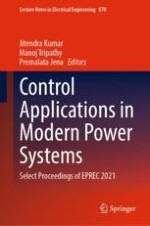2022 | OriginalPaper | Buchkapitel
Output Power Enhancement of VSWT Using Fuzzy Logic-Based MPPT Algorithm
verfasst von : Bhawna Saini, Bhavnesh Kumar
Erschienen in: Control Applications in Modern Power Systems
Verlag: Springer Nature Singapore
Aktivieren Sie unsere intelligente Suche, um passende Fachinhalte oder Patente zu finden.
Wählen Sie Textabschnitte aus um mit Künstlicher Intelligenz passenden Patente zu finden. powered by
Markieren Sie Textabschnitte, um KI-gestützt weitere passende Inhalte zu finden. powered by
